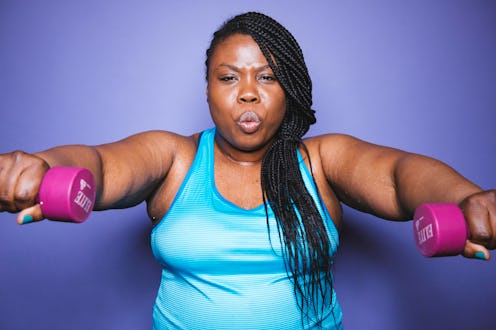Life
Why Are Women So Underrepped In Exercise Research?

It's (unfortunately) common knowledge that women have pretty much always been underrepresented in sports. I do believe it's getting better, and that we're finally starting to get some of the recognition we deserve — but there's still a huge gap in a related area: Women are largely underrepresented in exercise research. A 2014 study shows just how big the gap is, and you guys? It's a problem. It's really, really a problem.
NY Mag's Science of Us draws attention to a piece running on Science News, which brings the 2014 study back into some much-needed. focus. In the study, which was originally published in the European Journal of Sport Science, British exercise physiologist Joe Costello analyzed 1,382 articles from between 2011 and 2013 published in three popular journals in the field — research that utilized more than 6 million participants in total. Women comprised approximately 36 percent of the study participants per study, and just 39 percents of the total number of participants.
More research recent conducted by Science News' Bethany Brookshire looked at studies published between January and May of 2015. In total, she analyzed 188 studies using nearly 255,000 participants. Out of these 188 studies, 73 percent (138 of them) used at least some women. In general, women made up just 42 percent of the participants. Furthermore, 27 percent of the students were restricted to only men, while four percent were only women. Perhaps the biggest gap she found, however, was a pool of 29 studies and approximately 4,000 participants total: Only three percent were women.
All of this points back to one startling conclusion: When researchers study athletes, there's a severe lack of focus on women.
The ramifications of this are many. Women's bodies are different from men's. Our hormones are different. Many of us need more sleep. We experience pain differently. We lose fat and build muscle differently. We may have our own unique reactions to medications and supplements. And yet, we're required to rely more heavily on information geared toward the male anatomy? Something about that seems less than helpful at best and downright damaging at
As a competitive female athlete myself, I know firsthand how frustrating this is. It's even trickier considering that I train in the sport of Olympic weightlifting, a sport that is overwhelmingly male-dominated. While female weightlifters are nothing new, the information available on them isn't so plentiful. It's slowly getting better, as we're flocking to the sport in ridiculous numbers — but at present time, if I want to learn more about things like how my menstrual cycle affects my training and nutrition, what all of my hormones are up to, how I would want to adjust my training and nutrition if I were to become pregnant? Well, good luck to me, because that information often just isn't available.
Of course, there are general ideas and concepts that both men and women can probably accept. For example, if you consume more calories than you expend, you will slowly gain weight. Over-training has negative physical and mental side effects. Sleep is absolutely vital to recovery.
But my point is this: If I can find a plethora of information about the osteoarthritis of the lower limbs specifically in former male athletes... why can't I find enough about how my PMS affects my weightlifting?! This is clearly essential information, and yet because women are continually left out of the research being conducted, it — along with so many other vital pieces of knowledge — remains a mystery.
As I mentioned earlier, I do believe the situation is improving. It helps that both professional and non-professional female athletes are becoming public figures in their own right, largely thanks to social media. If there's a demand for information, the supply will have to follow.
Images: Andrew Zaeh for Bustle; Giphy (2)